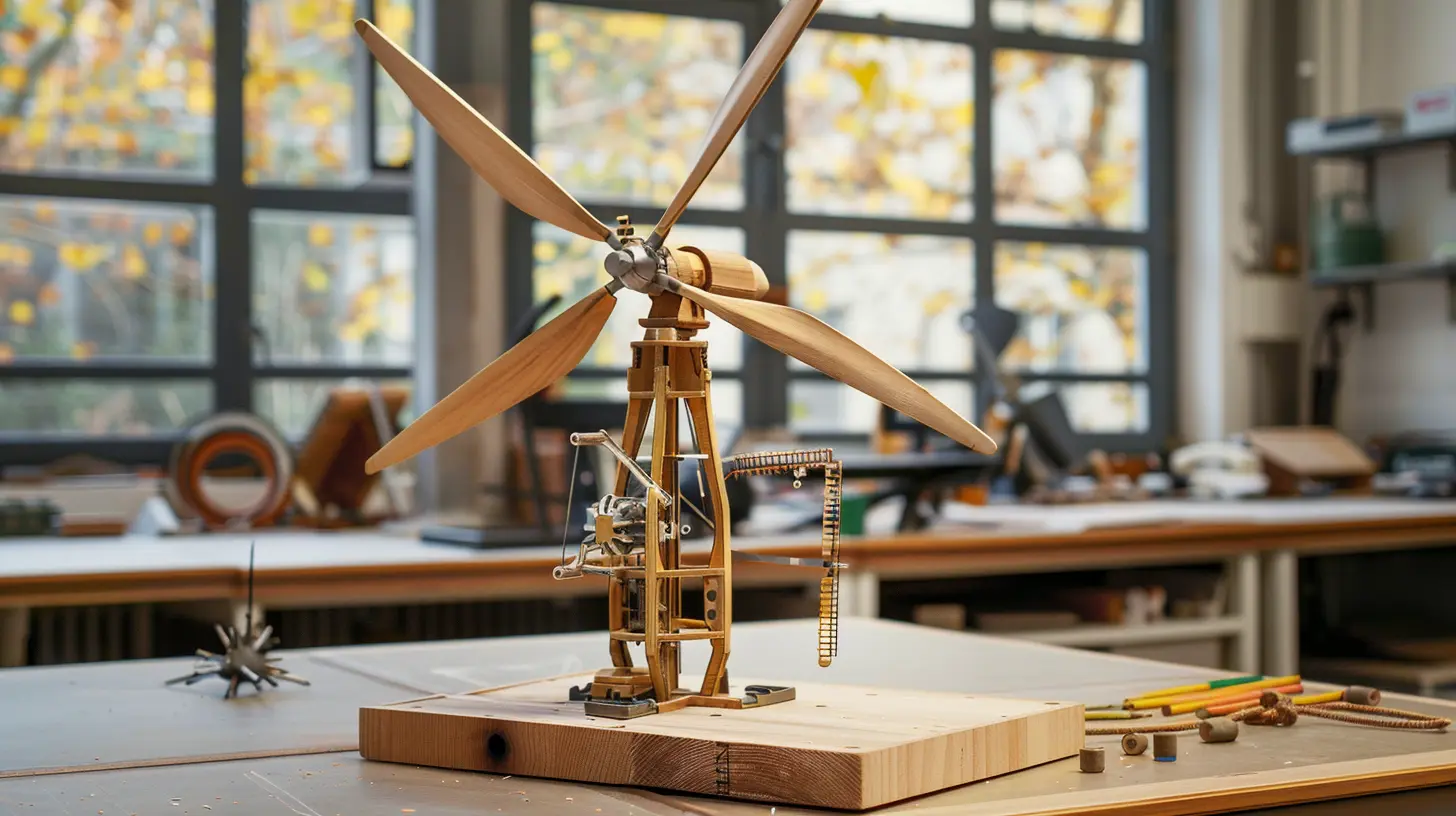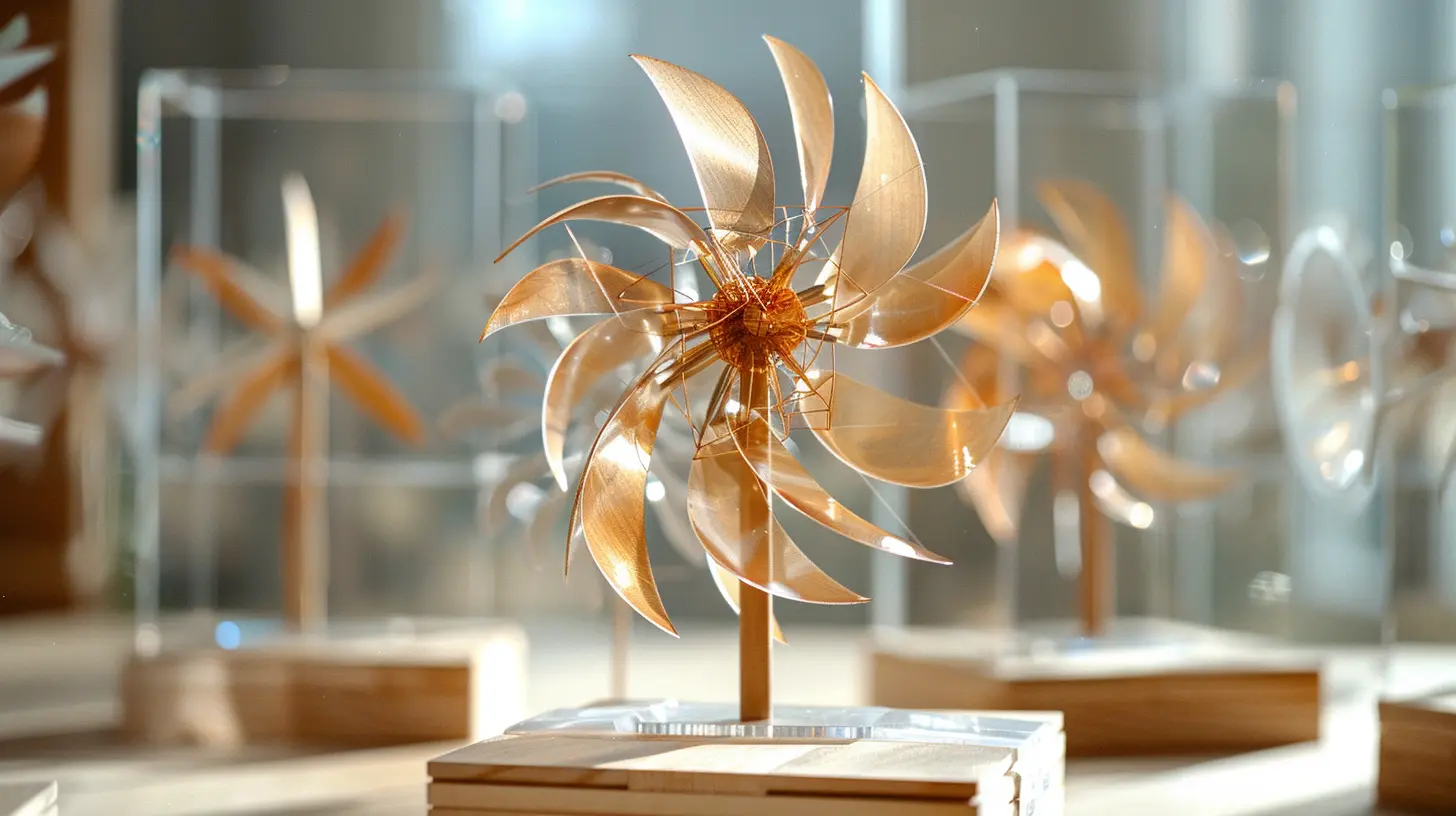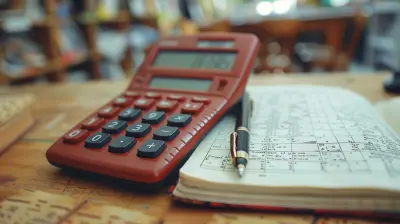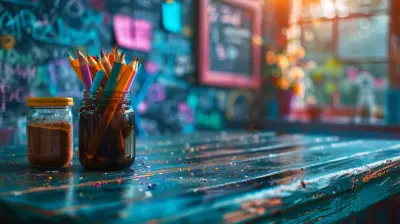Harnessing the Wind: Building Your Own Wind Turbine Model
18 January 2025
Ever looked up at a wind turbine and wondered, "How does that thing even work?" Well, you're not alone. Wind turbines are a fascinating way to generate clean, renewable energy, and the best part? You can actually build your very own wind turbine model at home!
Sure, it might not power your entire house, but it’s a fantastic way to learn about renewable energy, engineering, and how technology is helping to combat climate change. Plus, it’s a fun project you can complete with friends or family. Ready to dive into the world of renewable energy and DIY engineering? Let’s get started!

Table of Contents
1. The Basics: What is a Wind Turbine?2. Why Build a Wind Turbine Model?
3. Materials You'll Need
4. Step-by-Step Guide: Building Your Wind Turbine Model
- 1. The Foundation
- 2. Building the Tower
- 3. Creating the Blades
- 4. The Nacelle and Generator
- 5. Assembly
- 6. Testing Your Wind Turbine
5. The Science Behind Wind Turbines
6. Tips for Optimizing Your Wind Turbine Model
7. Frequently Asked Questions
8. Conclusion

The Basics: What is a Wind Turbine?
Before we dive into building your own wind turbine model, let’s break it down. A wind turbine is a device that converts kinetic energy from the wind into electrical energy. Think of it as a giant fan, but in reverse. Instead of using electricity to generate wind, it harnesses wind to generate electricity. Cool, right?Most wind turbines have three key components:
1. Blades – These catch the wind and cause the rotor to spin.
2. Tower – This is the tall structure that holds the blades high in the air where the wind is stronger.
3. Generator – This is where the magic happens. The spinning of the blades turns a generator, which produces electricity.
Don’t worry if all this sounds a bit technical. As we go through the process of building your own model, things will start to make more sense.
Why Build a Wind Turbine Model?
You might be asking, “Why would I want to build a wind turbine model when I can just Google how they work?” Well, let me tell you why.1. Hands-On Learning: There’s something about physically building something that makes the information stick. You’ll understand the mechanics and science behind wind turbines much better by getting your hands dirty.
2. STEM Skills: This project combines science, technology, engineering, and math (STEM) in a fun and practical way. Whether you’re a student or just curious about renewable energy, this is an awesome way to sharpen those skills.
3. Sustainability Awareness: Building a wind turbine model gives you a practical understanding of how renewable energy works. It’s a small step, but it can help foster a greater appreciation for sustainable living.
4. It’s Just Fun!: Let’s not forget – it’s a cool, creative project. Plus, you can impress your friends and family when you explain how it all works.
Materials You'll Need
Before we get into the actual steps, here’s a checklist of the materials you’ll need to build your wind turbine model. You can find most of these items at a local hardware store or online.- Small DC motor (acts as the generator)
- Plastic or wooden dowels (for the blades)
- Cardboard or plastic sheet (to shape the blades)
- PVC pipe or wooden stick (for the tower)
- Hot glue gun or strong adhesive
- Nuts and bolts (for securing parts)
- Small LED or light bulb (optional, to visualize power generation)
- Multimeter (to measure voltage output)
Step-by-Step Guide: Building Your Wind Turbine Model
Now, let’s get into the fun part – building your wind turbine model! Follow these steps carefully, and before you know it, you’ll have your very own mini wind turbine.1. The Foundation
First things first, we need a solid base to hold everything together. A stable foundation is key to ensuring your wind turbine doesn’t topple over once the blades start spinning.- Use a sturdy piece of wood or a heavy base to act as the foundation.
- Attach a PVC pipe or wooden dowel to the base. This will serve as the tower of your wind turbine.
2. Building the Tower
The tower is the main structure that holds the blades high enough to catch the wind.- Cut your PVC pipe or wooden dowel to the desired height (around 12-18 inches should be fine for a model).
- Secure it firmly to your base. Use bolts or glue, but make sure it’s sturdy.
3. Creating the Blades
Here’s where things get interesting. The blades are what capture the wind and cause the rotor to spin. You’ll need to get creative here, as the shape and angle of the blades can affect how efficient your turbine is.- Cut out three or four blades from a plastic sheet or cardboard. The shape should be long and slightly curved, like airplane wings.
- Attach the blades to a small circular hub (this could be a bottle cap or something similar), ensuring they are evenly spaced.
4. The Nacelle and Generator
The nacelle is the box at the top of the tower that houses the generator. For our model, the DC motor will act as the generator.- Attach the DC motor to the top of the tower. This will be your generator.
- Connect the blades to the shaft of the motor so that when the blades spin, they turn the motor’s shaft.
5. Assembly
Now it’s time to put everything together.- Attach the nacelle (with the motor) to the top of the tower.
- Secure the blades to the motor shaft.
- Ensure everything is tightly fastened, but still allows the blades to spin freely in the wind.
6. Testing Your Wind Turbine
Now that your wind turbine is assembled, it’s time to see if it works!- Place your wind turbine in a windy location or use a fan to simulate wind.
- If you’ve connected an LED or a multimeter, you should see it light up or register a voltage when the blades spin. Congratulations, you’ve just built a wind turbine!
The Science Behind Wind Turbines
So, how does it all work? The key principle behind a wind turbine is energy conversion. Wind (which is moving air) has kinetic energy. When the wind hits the blades, the kinetic energy is transferred to the blades, causing them to spin. This spinning motion turns the generator (or motor in our case), which then converts the kinetic energy into electrical energy.In larger, more complex wind turbines, this energy is then transferred to the electrical grid. But in our model, you’ll see this process in action by lighting up a small bulb or measuring voltage with a multimeter. Pretty neat, huh?
Tips for Optimizing Your Wind Turbine Model
Building a wind turbine model is one thing, but making it efficient? That’s a whole different challenge. Here are some tips to help you optimize your wind turbine for better performance:1. Blade Shape: The shape of your blades matters! Blades that are too flat won’t capture the wind effectively. Experiment with curved or angled blades to see what works best.
2. Blade Angle: The angle at which your blades are attached to the hub affects how much wind they can catch. Try different angles to optimize for maximum spin.
3. Wind Speed: The faster the wind, the more power you can generate. If you’re testing indoors, use a powerful fan for best results.
4. Friction: Make sure the blades can spin freely without too much resistance. Lubricating the motor shaft or ensuring a smooth connection between the blades and motor can help.
Frequently Asked Questions
1. How much power can a model wind turbine generate?
A small model wind turbine won’t generate much power. At most, it can light a small LED or register a few millivolts on a multimeter.2. Can I use this model to charge a battery?
Technically, yes, but it would take a lot of time and effort. The power output would be minimal, so don’t expect to charge your phone with it anytime soon.3. How can I make my wind turbine more efficient?
Focus on optimizing the blade design and angle. The more wind your blades can catch, the more power you’ll generate.Conclusion
Building your own wind turbine model is a rewarding and educational project. Not only do you get to learn about renewable energy, but you also develop a deeper understanding of mechanical engineering, physics, and sustainability. Plus, it’s just plain fun!So, whether you're a student working on a school project or simply someone curious about wind energy, this DIY wind turbine model is a fantastic way to start. Now, grab your materials, follow the steps, and see the power of the wind in action!
all images in this post were generated using AI tools
Category:
Science ExperimentsAuthor:

Bethany Hudson
Discussion
rate this article
16 comments
Greyson Wood
This article offers an inspiring and practical approach to renewable energy! Building a wind turbine model not only provides hands-on learning but also fosters awareness about sustainable practices. Thank you for sharing these valuable insights; I'm excited to try this project and explore the wonders of wind energy!
March 31, 2025 at 3:46 AM

Bethany Hudson
Thank you for your kind words! I'm glad to hear you're excited to try the project. Enjoy the journey into wind energy!
Finnian McNeely
What a fun project! Building a wind turbine model sounds like an amazing way to learn about energy!
March 7, 2025 at 5:32 AM

Bethany Hudson
Thank you! I'm glad you found it interesting—hands-on projects like this are a great way to explore renewable energy!
Lucy Beck
Great article! I appreciate the clear steps and insightful tips for building a wind turbine model. It’s inspiring to see how accessible renewable energy projects can be!
February 2, 2025 at 9:49 PM

Bethany Hudson
Thank you so much for your kind words! I'm glad you found the article helpful and inspiring. Happy building!
Teagan Soto
Building a wind turbine model offers hands-on learning about renewable energy, engineering principles, and environmental impact, inspiring innovation for a sustainable future.
January 30, 2025 at 11:53 AM

Bethany Hudson
Thank you! I'm glad you found the article insightful. Building a wind turbine model is indeed a great way to engage with renewable energy and inspire innovation.
Melanie Perez
Exciting project! Let's explore!
January 27, 2025 at 11:42 AM

Bethany Hudson
Thank you! I'm excited to share this journey with you! Let's dive in!
Daphne McCaw
This article brilliantly simplifies the process of building a wind turbine, making renewable energy accessible and fun. It inspired me to explore sustainable projects, highlighting the importance of hands-on learning in education.
January 26, 2025 at 1:25 PM

Bethany Hudson
Thank you for your kind words! I'm thrilled to hear that the article inspired you to explore sustainable projects and emphasized hands-on learning. Happy building!
Calaris McDowell
What an intriguing concept! Building a wind turbine model not only fosters creativity and innovation but also deepens our understanding of renewable energy. I can’t wait to explore the practical applications and potential benefits of this hands-on project!
January 26, 2025 at 5:49 AM

Bethany Hudson
Thank you! I'm glad you find the concept intriguing. I’m excited for you to dive into the project and discover its practical applications!
Brick McKay
Unlock the secrets of wind energy! Discover how crafting your own wind turbine model can propel you into a world of sustainable innovation and hidden possibilities.
January 25, 2025 at 1:46 PM

Bethany Hudson
Thank you! Crafting your own wind turbine model is a fantastic way to explore sustainable energy and unleash your creativity. Let's harness the wind together!
Porter Middleton
Building a wind turbine model fosters innovation and sustainability, empowering learners to engage with renewable energy.
January 25, 2025 at 3:39 AM

Bethany Hudson
Thank you! I'm glad you see the value in building wind turbine models to inspire innovation and promote sustainability.
Amelia McQuillan
This article effectively demystifies wind energy by guiding readers through the process of building a wind turbine model. It encourages hands-on learning and fosters an appreciation for renewable energy technology.
January 24, 2025 at 9:15 PM

Bethany Hudson
Thank you for your feedback! I'm glad you found the article helpful in making wind energy accessible and engaging.
Jemima McKinley
Who knew harnessing the wind could be so fun? Building your own wind turbine model is like crafting a mini superhero for clean energy! 🌬️✨ Perfect for little engineers and eco-warriors alike, this project promises a whirlwind of creativity and learning—so let’s get those blades spinning!
January 24, 2025 at 5:59 AM

Bethany Hudson
Thank you! I'm thrilled you found the project inspiring—it's a fantastic way to blend creativity with sustainability! 🌍💨
Lennox Morrow
What a fantastic guide! Building your own wind turbine model sounds like a fun and educational project. Can’t wait to try it out and harness some clean energy! 🌬️🔋
January 23, 2025 at 12:03 PM

Bethany Hudson
Thank you! I'm glad you found the guide helpful. Have fun building your wind turbine and enjoying clean energy! 🌟
Jessamine McConkey
Inspiring, practical, and empowering!
January 22, 2025 at 8:29 PM

Bethany Hudson
Thank you! I'm glad you found it inspiring and practical!
Benjamin Gates
This article effectively outlines key steps and considerations for creating a wind turbine model, fostering renewable energy awareness and hands-on learning.
January 21, 2025 at 8:53 PM

Bethany Hudson
Thank you! I'm glad you found the article helpful in promoting renewable energy and hands-on learning!
Pilar Warren
What a fantastic way to explore renewable energy! Building your own wind turbine model sounds like a fun and educational adventure. Can't wait to see how creativity and science come together in this exciting project! 🌬️💡
January 21, 2025 at 4:12 AM

Bethany Hudson
Thank you! We're excited to share the creative process and educational benefits of building a wind turbine model. Stay tuned for more updates! 🌍✨
Bellamy Myers
This article offers valuable insights into wind turbine construction. It inspires creativity and promotes sustainability, making renewable energy accessible. I'm excited to try building my own model!
January 18, 2025 at 1:01 PM

Bethany Hudson
Thank you for your kind words! I'm thrilled to hear you're inspired to build your own model. Best of luck with your project!
MORE POSTS

How to Stay Connected With Your Passion for Teaching

The Intersection of Social Justice and Environmental Education

The Role of Speech Therapy in Addressing Learning Disabilities

How to Create a Personalized Professional Development Plan

Navigating the Transition from High School to College

Rethinking Classroom Spaces for Blended Learning Settings

How to Build Strong Networking Skills for Career Advancement

The Role of Estimation in Everyday Math

How Collaborative Learning Transforms the Classroom Experience

Best Practices for Creating a Flipped Classroom